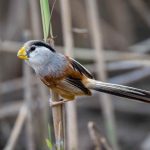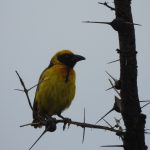The Birdist asked and answered the question, “Which Bird Has The Weirdest Range?” The answer might surprise you.
Recent Posts
 Demotivational Posters for Birds (IV)By Kai Pflug
Demotivational Posters for Birds (IV)By Kai Pflug 10 More Cute BirdsBy Kai Pflug
10 More Cute BirdsBy Kai Pflug Someone Asked for More LBJs?By Faraaz Abdool
Someone Asked for More LBJs?By Faraaz Abdool Ask A Bird Guide: What’s the hardest birding skill you’ve had to master — and how did you get better at it?By Editor
Ask A Bird Guide: What’s the hardest birding skill you’ve had to master — and how did you get better at it?By Editor We Missed the Fall Migration: But Rock Creek Park Still DeliveredBy Fitzroy Rampersad
We Missed the Fall Migration: But Rock Creek Park Still DeliveredBy Fitzroy Rampersad Bird City–An Author InterviewBy Donna
Bird City–An Author InterviewBy Donna The rediscovery of Uganda’s endemic Fox’s WeaverBy a Guest
The rediscovery of Uganda’s endemic Fox’s WeaverBy a Guest
Posting Calendar
| DAY | WRITER(S) | SERIES (weekly) |
|---|---|---|
| MON | Kai (w) | Birding Lodges |
| TUE | Donna (m) Susan (m) Hannah (m) Fitzroy (m) Grace (m) | Bird Guides |
| WED | Leslie (bw) Faraaz (bw) | Ask a Birder |
| THU | Paul (w) Cathy (bw) | Birder’s Lists |
| FRI | David (w) | Species Spotlight |
| SAT | Peter (bw) Luca (bw) | From the Archives |
| SUN | Clive (w) Sanjana (m) | Three Photos |
| w weekly, bw biweekly, m monthly | ||
| Any time: Jason, Mark, John, Sara, Rolf, Dragan | ||
See here for info on the writers.
Newsletter
Signup and receive notice of new posts!
Thank you!
You have successfully joined our subscriber list.





That’s awesome. I often wonder how much of that is an artifact of birder behavior. That one dot in upper Michigan appears to be over the Whitefish Point/Sault Ste. Marie area, which is one of the most heavily birded areas of the midwest.
I would have said the Azure Magpies. Whether you split them into two species or not, you can’t beat one population in China, and one in Spain, and nothing in between.
I assume they don’t count cause they aren’t in the US. 😛
@Kirby: I wonder – good question!
@Duncan: There are places outside of the United States?
@Duncan- I was going to suggest Azure-winged Magpie too. When I heard about that distribution for the first time I thought it was a joke.
Regarding Azure-winged Magpies: and they are very nice birds, too! Not like a certain heron who pals around with Yellow-crowned Youknowwhats!
I am not entirely sure but think I read somewhere that fossils of the magpies had been found in some areas between China and Spain/Portugal, supporting it is a natural distribution pattern and not – what has been / still is an alternate hypothesis – an early example of escaped captive birds from China establishing “wild” populations a long, long, long time ago.
It’s clearly an artefact of contraction, given that DNA analysis shows they have been apart for a million years. A more confusing disjunct distribution are the Cyanoramphus parakeets, which are found in New Zealand and New Caledonia and the surrounding islands, and were found in the Society Islands, but nowhere in between, even in the fossil record.